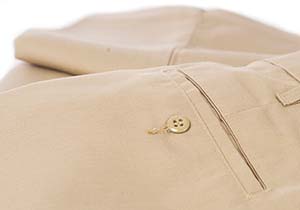
One sign of a well-made pair of pants is the use of topstitches sewn parallel to a seam to help fabric facings stay in place; another indicator is button holes bound with thread for added durability.
WILMINGTON, MA () – In today’s competitive business environment, “You are what you wear.”
In the minds of consumers, employees outfitted in work clothing that’s mismatched, dirty, disheveled, or just poorly made, can call into question the quality of products or services they provide.
By the same token, workers who dress in clean, attractive uniforms can have the opposite effect: customers will attribute positive impressions to the company itself, and that help the bottom line.
Studies have shown that the quality of work clothing can also have an effect on its wearers and their productivity. It’s what researchers at Northwestern University refer to as “enclothed cognition.”
In an interview with ABC News, Adam Galinsky, a professor of management at Northwestern who authored the “enclothed cognition” study says wearers have a tendency to “take on the (quality) characteristics of (their) clothes.” Translated simply, that means if you dress in quality workwear, you’ll perform your work in a quality manner.
So how can you tell if work apparel is actually made well? “The devil is in the details,” says Adam Soreff, Director of Marketing for UniFirst Corporation (unifirst.com), a leading manufacturer and supplier of work uniforms and related services such as laundering, maintenance, mending, and program management of employee apparel programs for businesses throughout the U.S. and Canada. He continued, “You should read and compare fabric labels, and examine work clothing closely to assess overall quality.”
Here are 10 tips for identifying quality uniforms and work apparel:
- Look for fabrics made from “ring spun” fibers. Such fibers help make work apparel more durable, softer, and lighter to wear. Ring spun fibers also allow work clothing to retain its shape so wearers don’t appear disheveled but, instead, project a continuous professional image.
- Take a close look at the stitching. The tighter the stitching pattern or the number stitches per inch (SPI), is a good indicator of quality. For a quick test: grab the fabric at the seams with both hands and gently pull. The threads should hold securely.
- Look for two-piece construction on shirt collars. Known as a “banded collar,” this extra construction method adds rigidity to collars, creating a more professional appearance. When do you want one-piece construction? Think pajamas.
- Check for triangular sewn tacks on pocket corners. Such tacks strengthen the stress points where pockets most often tear.
- Test for sewn-in collar stays. These are almost always made of thin plastic pieces that are inserted into the tips of collars during the manufacturing process to help them retain shape and prevent curling. Lift a collar to reveal the underside and feel for the stay. Is there a nice tight pocket formed from stitching to keep it in place at the pointed collar tip? For work shirts, collar stays should be stitched down to the bottom ply of the collar to prevent shifting or fall out.
- Examine shirt cuffs for lining. Flip the shirt cuff inside out: Is it two-ply? If so, the fabric has been folded in half and stitched together to form the outside and the lining of a quality cuff. This adds strength and a nice heft to the sleeves to help keep them comfortably in place.
- Examine pants pockets for topstitching. Topstitches are sewn parallel to a seam or along a hem to help fabric facings stay in place and provide a crisply styled edge to pant pocket openings.
- Look for wider belt loops and back pockets. Narrow pocket openings, especially, can be annoying while performing certain work tasks. And larger work belts will have less room to move with you, causing discomfort, and will eventually rip narrower loops.
- Check Pant legs for ample bottom hems. Fold the bottom of the pant leg over and take a peek. How much fabric is doubled over and sewn there? A larger hem adds weight so pant legs drape better, and helps form a nicely defined hem crease.
- Inspect fasteners. Whether buttons, snaps, Velcro®, or zippers, ensure that all fasteners on shirts and pants are sewn on securely. Button holes in well-made garments are often bound with thread for added durability; zippers should move freely up and down without hesitation.
Wearing uniforms and work apparel that meet these 10 criteria will help make more positive impressions with customers. Of course even a quality garment won’t portray the right image if it’s dirty, wrinkled, or in need of mending. And that’s why managed uniform programs that include services like pickup and delivery, laundering, pressing, mending, and automatic replacements are popular with companies that wish their employees to be “dressed for success.”
About UniFirst
UniFirst (NYSE: UNF), a North American leader in the supply and servicing of uniforms, workwear, and protective clothing, outfits more than 1.5 million workers each business day. The company’s most popular brands include UniWeave®, SofTwill®, UniWear®, and Armorex FR®. UniFirst also offers Facility Service programs including floor mats, mops, and restroom products. For more information, contact UniFirst at 888-879-2169 or visit UniFirst.com.
